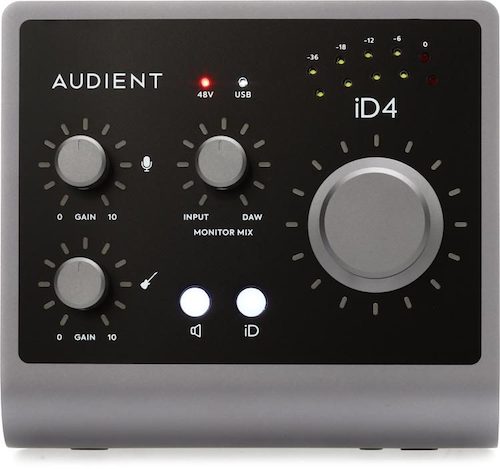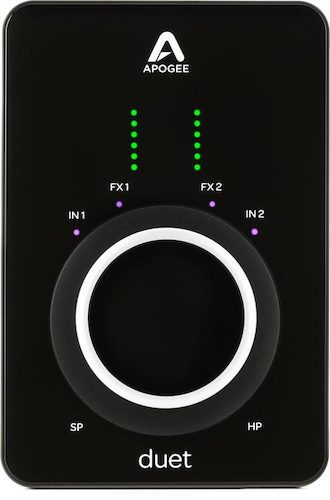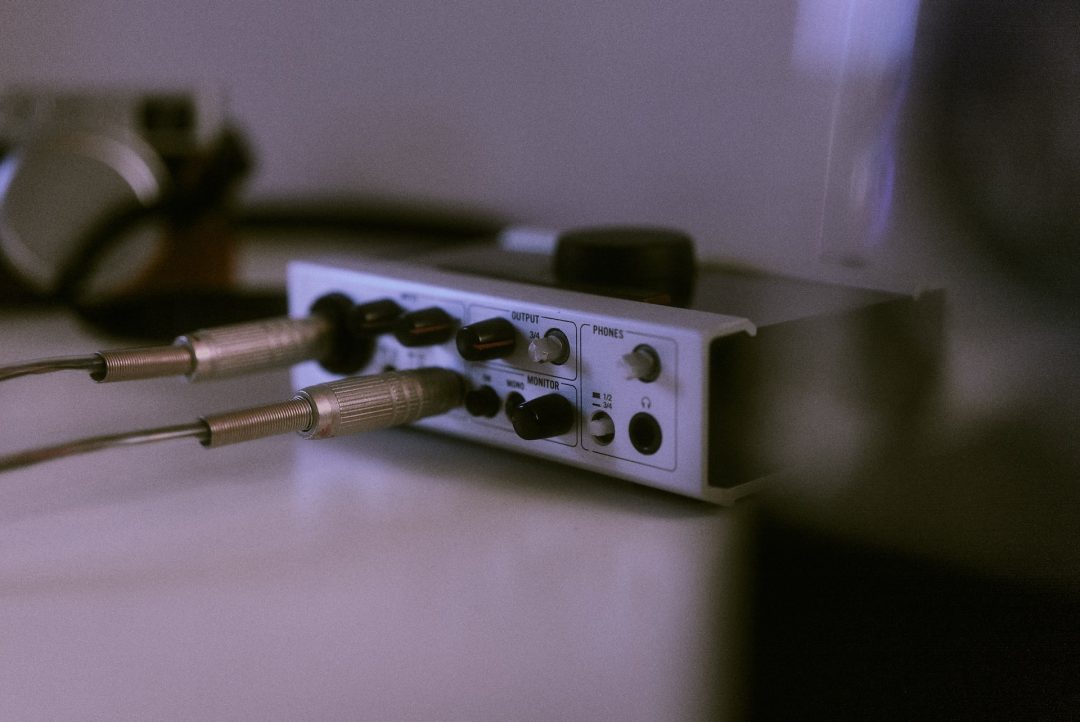Looking for the perfect audio interface to enhance your sound experience? You’ve come to the right place! Our guide to the best audio interfaces of 2024 is designed to cater to every budget and need.
Whether you’re a professional or just starting out, our comprehensive reviews, comparisons, and expert recommendations will help you find the ideal solution. Stay tuned to discover the ultimate audio interface that suits your requirements and unlocks limitless possibilities for your creative endeavors.
What Is an Audio Interface?
An audio interface is a piece of hardware that we connect to our computer through USB, which is used for recording and playback. A basic device consists of an XLR input, a preamp that boosts the mic-level signal, a headphone amplifier/output, and a pair of outputs for speaker monitors. Higher-end models may include inputs and outputs likes MIDI and multiple line-level connections. They may also have miscellaneous features such as a built-in talkback.
How Does an Audio Interface Work?
One of the most essential concepts of an audio interface is the conversion of analog to digital (ADC) and the subsequent conversion of digital signals back to analog (DAC). This process takes place instantly over a binary stream of 0s and 1s, which is connected to our computer.
- RELATED: Best Audio Interface for Mac
- RELATED: Best USB Interfaces for $100 or Less
The A to D conversion takes the signal from a microphone or instrument and transforms it into a digital signal that can be recorded in our DAW software. Once inside the DAW, the interface performs the job of converting the digital material back to an analog signal, which can then be played through our headphones or speakers.
Factors to Consider When Choosing an Audio Interface
- Inputs & Outputs: How many XLR inputs and preamps do you need? Do you require MIDI, more than one pair of speakers, or other types of inputs and outputs?
- Connectivity: What type of USB connection do you need (Type A, C, etc.)?
- Portability: Do you plan to make music on the go or set up a dedicated home studio space?
- Converter and recording quality: Consider the standard quality to be 24-bit/44.1 or 48 kHz. However, some interfaces can record up to 24-bit/192 kHz.
- Price: What is your budget for the audio interface?
The 10 Best Audio Interface Options for Your Studio
1) Audient iD4 MkII

The Audient iD4 is a small yet powerful interface designed to deliver high-quality recordings. It features a single Class-A microphone preamp and a JFET instrument input, which can capture audio up to 24-bit/96 kHz resolution. The Audient iD4 boasts class-leading conversion technology, which ensures exceptional recording and playback quality.
Additionally, it includes an excellent 600Ω headphone amplifier that can drive even the most high-end headphones.
2) Focusrite Scarlett 4i4

The Scarlett series by Focusrite is one of the most popular choices for entry-level audio interfaces. The 2i2 is a best-selling model that is often preferred by first-time users. In this lineup, we have included the 4i4, which offers two microphone preamps, two line inputs, four line outputs, MIDI in and out, and a pristine Air control that enhances the preamps’ high-frequency response for added color.
Whether you choose the 4i4 or any other model from the Scarlett range, you can be confident that you are making a great choice as a first-time user.
3) Universal Audio Volt 2

Universal Audio’s Apollo interfaces are some of the company’s most well-known products that are widely used. However, their newer Volt interfaces combine Universal Audio’s quality craftsmanship with affordability for everyone.
The Volt 2 is a USB-C interface that includes two microphone preamps, a pair of monitor outputs, and MIDI in/out. What sets the Volt 2 apart is the ability to turn on a “Vintage” circuit that emulates the character of the classic UA 610 tube preamplifier.
4) Behringer U-Phoria UMC202HD

Behringer provides a range of U-Phoria products in various configurations, offering some of the most cost-effective options currently available. The U-Phoria 202HD device includes two mic preamps, designed by MIDAS, with Neutrik combo jacks for mic, line, or Hi-Z inputs.
Despite its affordability and portability, this simple device delivers impressive conversion and resolution, operating at 24-bit/192 kHz.
5) MOTU M6

The MOTU M6 is an audio interface that has 6 inputs and 4 outputs, which connects to your computer through USB-C. It features 4 microphone preamps, 2 line inputs, 4 line outputs, and 2 headphone outputs, which makes it perfect for recording, mixing, and broadcasting.
The interface is powerful enough to handle various tasks with ease. Additionally, the bright LED screen provides visual feedback with level meters, which is a nice feature to have at this price point.
6) Antelope Audio Orion Studio Synergy Core

Antelope has released a professional rack-mounted audio interface called the Orion. This company has been a leader in innovation for years now. The Orion comes with 12 preamps, four on the front and eight on the back, as well as D-Sub and ADAT connectivity.
It also has A and B monitor outputs and a plugin suite that takes advantage of Antelope’s Synergy Core FX DSP, which is a recently developed technology. If you are setting up a studio space and need a professional-grade interface to bring everything together, the Orion is an excellent choice.
7) PreSonus Studio 26c

PreSonus interfaces are known for their portability, affordability, and usability. Among the popular choices for many consumers is the 26c. This USB-C device boasts two award-winning XMAX preamps, four line outputs, and MIDI I/O. Advanced monitoring features an A/B cue mix, and the LED panel allows for easy metering at a glance.
8) Universal Audio Apollo x8 Heritage Edition

Universal Audio’s rack-mount “x” series interfaces are known for their exceptional quality. Among them, the Thunderbolt 3 x8 model is particularly impressive, with 18 inputs and 24 outputs. It boasts four Unison-enabled microphone preamps, which means that users can record and print through analog emulations of classic preamps and effects in real-time.
This professional interface also includes support for 7.1 monitoring, built-in talkback, dual headphone outputs, and 6-core DSP, making it a complete and highly versatile solution for audio professionals.
9) Audient EVO 16

Audient is known for its innovative and futuristic-looking interfaces that push the boundaries. If you’re looking for a reliable and powerful interface that can handle even the most demanding projects, the EVO 16 is the way to go.
It boasts eight EVO preamps, two JFET instrument inputs, industry-leading conversion, eight line outputs, and ADAT, making it a verifiable workhorse of an interface. What’s more, it offers an impressive level of features and quality that you won’t find in any other interface at the EVO 16’s price point.
10) Apogee Duet 3

The Apogee Duet 3 is a compact 2-in/4-out USB-C interface that boasts a pair of top-notch mic preamps. With onboard DSP, you can customize the tone and character of your recordings, giving you a warm and analog-like sound through a high-quality digital interface.
The device is small enough to fit in your pocket, making it a highly portable option for musicians and recording enthusiasts.
- RELATED: Apogee Duet 3 Review
- RELATED: Apogee Boom Review: Should You Use This Audio Interface?
Frequently Asked Questions
What Audio Interface Do Professional Studios Use?
Professional recording studios need audio interfaces that provide excellent sound quality, low latency, versatile connectivity, and reliable driver support. Renowned brands such as Universal Audio, Focusrite, Apogee, Antelope Audio, and Audient offer high-quality audio interfaces that meet these requirements.
Which Audio Interface Sounds the Best?
To choose the best audio interface, consider the quality of ADCs and DACs, preamp performance, overall circuit design, and your sonic aesthetic. High-quality ADCs guarantee minimal noise and distortion, while premium DACs preserve the original sound’s nuances.
A high-quality preamp provides clean gain with low noise levels, resulting in a more detailed and transparent sound. The overall circuit design, including components like capacitors, resistors, op-amps, and power supplies, can affect the audio interface’s sound quality.
Are High End Audio Interfaces Worth It?
High-end audio interfaces offer superior preamps, converters, and components that can enhance the sound quality of recordings. They also provide advanced features for professional audio engineers and are made with premium materials for durability.
Despite their higher cost, they offer great value for professionals seeking uncompromising quality and advanced features.
Conclusion: Which Audio Interface Is Right for Me?
The decision of choosing the perfect audio interface for you should now be much clearer. It all boils down to aligning the interface with your unique needs and financial plan.
Our diverse selection caters to everyone, from emerging artists to professional sound engineers, ensuring that you find a match that resonates with your sound quality, functionality, and price requirements. Consider the essential features that will benefit your projects, ensure compatibility with your existing equipment, and ponder the potential for your future endeavors.
Choosing the right audio interface is crucial for achieving professional-grade sound and turning your creative visions into reality. Take a moment to make an informed decision, and propel your audio production to unprecedented heights
Advance Your Career in Music Production
Aspiring to make a mark in the music industry? The Produce Like A Pro Academy can set you on the right path with its extensive educational materials and supportive network of professionals. Here, you’ll find everything you need to master the art of audio production, from in-depth tutorials to hands-on courses.
Embrace the opportunity to learn from the best and connect with other music enthusiasts by joining our Academy today!




